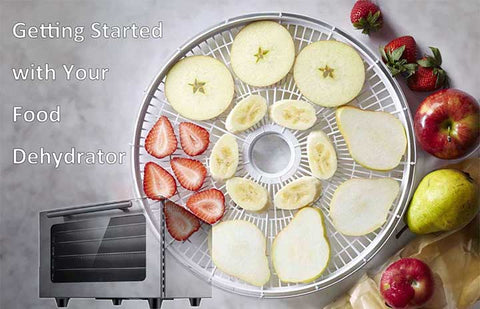You've invested in a new food dehydrator and are excited to start drying food to enjoy all year round. But where do you begin?
Here are some tips to make the most of your new appliance:Choose Your First Foods. Fruit is an excellent fast food to dehydrate as it is easy to prepare and results are quick.
Good options include apples, bananas, grapes, berries, and mangoes. Berries like strawberries can be dried whole, while most other fruits should be sliced about 1/4 inch thick.
Prep your produce by washing and drying it thoroughly before slicing or chopping. Berries can be left whole. Fruit with peels , such as apples and pears, should be peeled for a better texture.
Remove stems, seeds, and membranes. Place on trays. Arrange food in a single layer, not overlapping or crowded, on dehydrator trays lined with non-stick drying sheets. Space it out to maximize air circulation.
Fruit slices work best when placed side by side or in rings.Set the temperature and time according to your dehydrator's instructions or online charts for recommended temperatures and times for specific foods. Most fruits dehydrate between 135-145°F for 6-12 hours. Rotate trays halfway through for even drying. Store your bounty cool, dried foods completely before storing, which helps prevent mold.
Transfer to airtight containers or ziplock bags and store in a cool, dry place for up to one year. Enjoy your snacks or rehydrate for cooking. Once you've successfully dried some fruits, branch out to vegetables, meats, and more using the same basic method.
Get creative with flavors by adding fresh herbs, seasonings, or sauces to your dishes.Start simple, follow the guidelines, and your food dehydrator will deliver flavorful snacks and ingredients that you can enjoy all year long. Happy dehydrating!
Here are some additional tips to enhance your food dehydrating experience:Experiment with different fruit combinations: Mix and match various fruits to create unique flavor combinations.
For instance, try dehydrating apples with cinnamon or adding a squeeze of lemon juice to prevent browning. Try savory options: While fruits are a popular choice, don't forget about vegetables!
Dehydrate vegetables like carrots, bell peppers, or tomatoes to use in soups, stews, or as a crunchy snack.Consider making fruit leathers: Blend fruits such as strawberries, peaches, or raspberries with a little honey or sugar.
Spread the mixture thinly on dehydrator trays to create tasty and healthy fruit leathers.Dry herbs and spices: Utilize your food dehydrator to preserve fresh herbs from your garden.
Rinse herbs like basil, rosemary, or thyme and store them in airtight containers to add flavor to your dishes year-round. Try dehydrating meats: Make your own jerky by slicing lean meats like beef, chicken, or turkey thinly.
Marinate the meat in your favorite seasonings before dehydrating it for a delicious and protein-packed snack. Don't forget about yogurt and granola: You can also use your food dehydrator to make homemade yogurt or dehydrate granola for a nutritious and portable breakfast option.
Expand your culinary horizons by dehydrating international cuisines, such as kimchi, miso paste, or pasta sauces. By dehydrating these ingredients, you can easily incorporate them into your cooking.
Be creative with your presentation: After dehydrating your food, try arranging it in decorative jars or packaging it in personalized gift bags. This way, you can share your homemade dehydrated treats with friends and family.
Keep in mind that the possibilities with your food dehydrator are endless. Don't be afraid to try new recipes and techniques to maximize your investment. Enjoy the process and savor the flavors of your homemade dried foods throughout the year!

